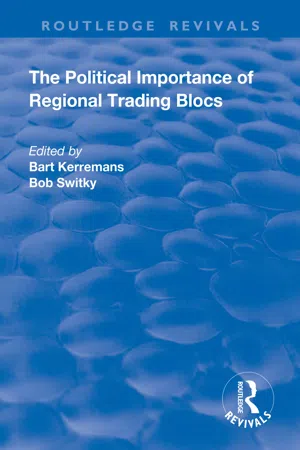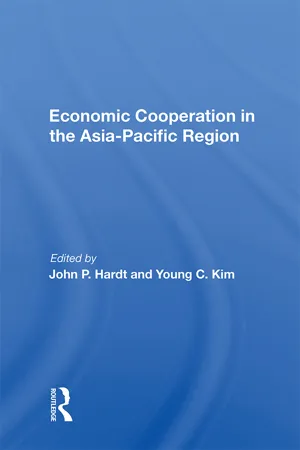Economics
Trading Blocs
Trading blocs are groups of countries that form an agreement to reduce barriers to trade among themselves while maintaining barriers for non-member countries. This can lead to increased trade and economic cooperation among member countries, as well as potential trade diversion away from non-member countries. Examples of trading blocs include the European Union and the North American Free Trade Agreement (NAFTA).
Written by Perlego with AI-assistance
Related key terms
Related key terms
1 of 4
Related key terms
1 of 3
3 Key excerpts on "Trading Blocs"
- Bart Kerremans, Bob Switky(Authors)
- 2018(Publication Date)
- Routledge(Publisher)
Finally, another distinction can be made between advanced industrial countries and developing countries. 14 Explanations for the Emergence of Trade Blocs at Higher Levels of Analysis Classical Trade Theory and Customs Union Theory The literature on trade blocs is, for the most part, quite recent. Classical economics, Marxist analyses, and even the interdependence literature virtually ignored the subject. The classical, liberal economic approach, for example, assumed that in a world capitalist system, economic relations will result in a division of labor that integrates all countries on a global scale. If there is a breakdown of an open trading system, the prediction is for a rise in protectionist, beggar-thy-neighbor policies. The possibility of various states banding together to ease the deleterious effects of a closing world economy had – until recently – received little attention. The choice was between an open system based on multilateralism or a closed (or closing) system based only on bilateralism. More promising economic work on regionalized trade has been based on Customs Union Theory which posits that when a customs union is formed, trade is both created and diverted. Internally, potential member states expect the combination of economies of scale and lowered trade barriers facilitate trade. Within such a regional trading arrangement, countries also achieve gains to trade through the reciprocal exchange of concessions on trade barriers and greater market access. Externally, the privileges to states within the union are not shared with those on the outside giving a de facto advantage to union members (Viner, 1961). Two recent examples of trade diversion involves NAFTA discrimination against the EU firms. First, European telecommunications equipment exporters face Mexican tariffs of 15-20% compared with tariffs of less than 5% within NAFTA- eBook - ePub
- Penelope Hartland-thunberg(Author)
- 2019(Publication Date)
- Routledge(Publisher)
The only other Trading Blocs that have approached achieving total free trade in their internal exchanges are the Central American Common Market (CACM) and the Caribbean Common Market (CARICOM); trade in nearly all the goods that are exchanged among the members is duty free. The other blocs have done little other than exchange preferences for a few products. The ineffectiveness of most Trading Blocs among developing countries is traceable to great differences in the economic structure of members, to their having established no agreed schedule of intra-bloc duty reductions, and/or to political disputes and jealousies among members. Originally both CACM and the East African Common Market (EACM), for example, contained much promise for successful regional integration, but as a result of mounting political controversy among members in the late 1960s, each began to disintegrate. Today intra-block trade is smaller than before the formation of EACM. The intra-bloc share of CACM trade has declined since the "soccer war" of 1969 after which Honduras and El Salvador refused to trade with one another. For other members, it is still an effective organization, although the recent upheaval in Nicaragua puts its future in doubt.Table I (page 6) shows the share of world trade accounted for by each trading bloc in 1976. In the aggregate, these blocs represented more than half of world trade, but excluding the European blocs they accounted for only 11 percent of world trade. Annex tables A-1 show the slow growth of intra-bloc trade in relation to total exports for each trading bloc.The successful accomplishment of the basic goal of Trading Blocs, the stimulation of intra-bloc trade through the reduction of tariff levies among members, is perhaps the most significant indication of their effectiveness. Looking at the LDC Trading Blocs in the aggregate, the relative importance of their intra-bloc exports to their total exports rose from 7 percent in 1965 to 12 percent in 1975. In largest part, however, this increase is accounted for by the importance of petroleum in the intra-bloc trade of the two oil-producing blocs, ASEAN and LAFTA. Omitting these two from the totals, intra-bloc trade as a share of the total remained roughly constant between 1965 and 1975. (The data show an increase from 5 percent to 7 percent. See Notes to Annex III - eBook - ePub
- John P Hardt(Author)
- 2019(Publication Date)
- Routledge(Publisher)
Table 10.10 , 89 percent of the executives agreed that the international economy is moving in the direction of regional Trading Blocs. Meanwhile, 76 percent felt that the shift to regional Trading Blocs would hurt the U.S. economy; 64 percent said they felt this shift would hurt the world economy.Three-quarters of the surveyed executives said they felt that the trend toward regional Trading Blocs would hurt the current round of GATT talks. Also, 64 percent said they felt U.S. workers would be hurt by these trends.About 66 percent of the surveyed U.S. executives said they felt most of the NIEs would rather form a regional trading bloc with the United States than with Japan. At the same time, the survey results showed strong U.S. interests in signing free-trade agreements with other countries.Table 10.10 The Role of Regional Trading Blocs in the World EconomyThese NPA survey data point to several trends within the U.S. business and labor communities, including the following:1. Percent of surveyed U.S. executives who believe that the world economy is shifting in the direction of regional Trading Blocs. 89% 2. Percent of surveyed U.S. executives who believe that regional Trading Blocs would hurt the GATT talks. 75% 3. Percent of surveyed U.S. executives who believe that the NIEs would rather form a trading bloc with the United States than with Japan. 66% 4. Percent of surveyed U.S. executives who believe that the United States should sign free-trade agreements with the following nations: Mexico 66% One or all of the NIEs 41% The European Community 55% Japan 41% Source: Estimates based on 1989 NPA survey data.- A lack of great faith in the GATT to reform itself;
- A feeling that regional Trading Blocs will increase in importance;
- A concern that the United States should give primary concern to the formation of free-trade agreements that favor U.S. interests; and
Index pages curate the most relevant extracts from our library of academic textbooks. They’ve been created using an in-house natural language model (NLM), each adding context and meaning to key research topics.
Explore more topic indexes
Explore more topic indexes
1 of 6
Explore more topic indexes
1 of 4


